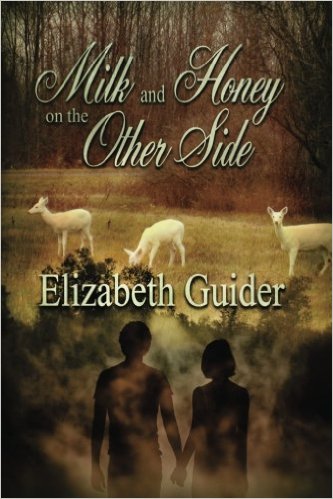The new novel Milk and Honey on the Other Side serves up a broadly compelling forbidden inter-racial romance in the post-War/pre-Depression South that is as authentic of the era and region as you will find.
A ferry carries a young Caucasian woman in Vicksburg, Mississippi across the river to her aunt’s farm in Louisiana where she becomes smitten with a smart and handsome mixed-race neighbor and handyman. But the flame that is ignited must remain on simmer for many years as author Elizabeth Guider carries the characters and the reader engagingly from the final days of World War I, through local societal, political, business, and familial upheavals, the Great Mississippi Flood of 1927, and into the early days of the Great Depression (and even through World War II in the epilogue).
<Review continues below the image…>

Aurelia Ackermann is the middle child of three offspring of a banker and local politician in Vicksburg, with two brothers, a by-the-book war veteran older sibling, and the younger one subject to ridicule due to his stuttering speech and occasional seizures. Aurelia is fortunate to have a relatively liberal father who is the least racist of any of his peers, an even more understanding aunt, who is the employer of the object of her affection, and a very forward-thinking and ambitious friend she meets in college.
But even the measured tolerance of some of her closest family and friends is not nearly equivalent in that time and region to an endorsement or approval of her passion, and does little to prevent the bigoted verbal and physical attacks on she and her suspected paramour.
 Guider, former editor of The Hollywood Reporter and Executive Editor and international TV reporter at Variety (where she edited some of my stories in the early 2000s), exhibits a remarkably deft hand in only her second novel at creating and introducing us to fully-developed characters and personalities who immediately capture our interest and empathy. In each of the 55 chapters and right up until the last of the 356-page saga we are genuinely interested in what happens to and what becomes of each of the main characters as well as several of the minor players.
Guider, former editor of The Hollywood Reporter and Executive Editor and international TV reporter at Variety (where she edited some of my stories in the early 2000s), exhibits a remarkably deft hand in only her second novel at creating and introducing us to fully-developed characters and personalities who immediately capture our interest and empathy. In each of the 55 chapters and right up until the last of the 356-page saga we are genuinely interested in what happens to and what becomes of each of the main characters as well as several of the minor players.
Guider, a Southern-born former American literature professor in Rome and Paris with a doctorate in Renaissance Studies, creates such an authentic sense of the setting with her vivid descriptions of everything from furniture, food, newspapers, and clothing of the day, to horse carriages and brands of early automobiles, that everything feels tangible.
In fact, one of only a few minor criticisms would be that she often uses names for objects that will be unfamiliar to the reader. She also uses dozens of expressions in French and at least 90 words unfamiliar to me. Some of these are somewhat generally decipherable in context, but many are not. I do enjoy being sparked to look up and learn new words when reading, especially when it’s easy with the e-book version that offers a simple touch-definition option, but the frequency here borders on becoming a distraction and minor frustration at times.
Some readers may find Guider’s writing style unique, in that there are many sentence constructions that sometimes seem to be incomplete or run-on, and certainly many with multiple hyphenates, requiring the reader to go back and re-read it a couple times to understand it.
But these are quibbles. Milk and Honey On The Other Side is a pleasure to read, not just for those interested in romance, but anyone who enjoys appealing characters in an engaging story with impressive historical context and references.
— By Scott Hettrick
